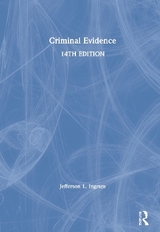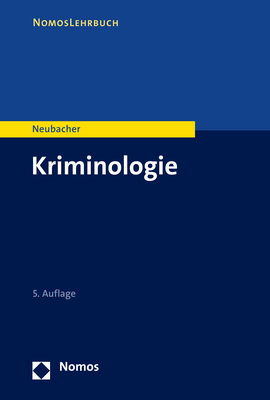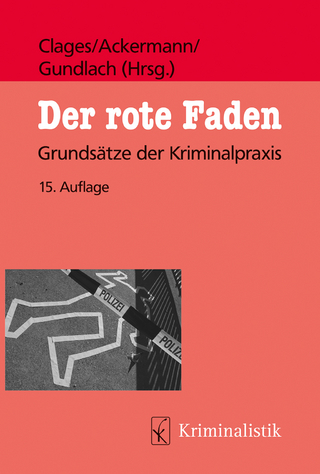
Criminal Evidence
Routledge (Verlag)
978-1-138-28904-8 (ISBN)
- Titel erscheint in neuer Auflage
- Artikel merken
Part of the John C. Klotter Justice Administration Legal Series, this thirteenth edition provides many updates, including new references to recent Supreme Court cases, such as the decision on same-sex marriage, and a current version of the Federal Rules of Evidence. Student aids include chapter outlines, key terms and concepts lists, a table of cases cited, and online case study questions and glossary. Teacher resources include an instructor’s guide, test bank, and PowerPoint slides.
Jefferson L. Ingram holds the rank of Professor in the Department of Political Science at the University of Dayton. He has a B.S. in secondary education, an M.A. in history, and a Juris Doctor. He is a member of the Ohio Bar, the Florida Bar, the Bar of the federal courts for the Southern District of Ohio, and the Bar of the Supreme Court of the United States.
Preface x
Acknowledgments x
PART I
History and Approach to Study
Chapter 1
History and Development of Rules of Evidence
1.1 Introduction
1.2 Early Attempts to Determine Guilt or Innocence
1.3 Modern Legal Systems—Romanesque System
1.4 —Anglican System
1.5 Development of the Rules of Evidence in the United States
1.6 Application of the Rules of Evidence in State and Federal Courts
1.7 Future Development of the Rules of Evidence
1.8 Summary
Chapter 2
Approach to the Study of Criminal Evidence
2.1 Introduction
2.2 Definitions
2.3 Reasons for the Rules of Evidence
2.4 Reasons for Excluding Evidence
2.5 Rules of Evidence in Criminal Cases Compared to Rules of Evidence in Civil Cases
2.6 Pretrial Flow of Evidence
2.7 Use of Evidence at the Trial
2.8 Consideration of Evidence on Appeal
2.9 Use of Evidence at the Probation Hearing
2.10 Use of Evidence When Considering Parole
2.11 Summary
Proof by Evidence and Substitutes
Chapter 3
Burden of Proof
3.1 Introduction
3.2 Definitions and Distinctions
3.3 Preponderance of the Evidence
3.4 Clear and Convincing Evidence
3.5 Beyond a Reasonable Doubt
3.6 Burden on the Prosecution
3.7 Burden to Prove All Elements of the Crime
3.8 Burden on the Accused
3.9 Burden of Proving Affirmative Defenses—General
3.10 —Alibi
3.11 —Insanity
3.12 —Self-Defense
3.13 Sufficiency of Evidence
3.14 Summary
Chapter 4
Proof via Evidence
4.1 Introduction
4.2 Pretrial Motions Pertaining to Evidence
4.3 General Approach to Admissibility
4.4 Order of Presenting Evidence at the Trial
4.5 Procedure for Offering and Challenging Evidence
4.6 Role of the Trial Judge in Evidence Matters
4.7 Function of the Jury
4.8 Role of Witnesses
4.9 Prosecuting Attorney’s Responsibilities
4.10 Defense Attorney’s Responsibilities
4.11 Admissibility and Weight of Direct and Circumstantial Evidence
4.12 Summary
Chapter 5
Judicial Notice
5.1 Introduction
5.2 Judicial Notice Defined
5.3 Judicial Notice of Facts
5.4 —Matters of General Knowledge
5.5 —History and Historical Facts
5.6 —Geography and Geographical Facts
5.7 —Facts Relating to Nature and Science
5.8 —Language, Abbreviations, and Symbols
5.9 Judicial Notice of Laws
5.10 —Law of the Forum
5.11 —Federal Law
5.12 —Law of Sister States
5.13 —Law of Foreign Countries
5.14 —Municipal Ordinances
5.15 —Administrative Regulations
5.16 —Jurisdiction of Courts
5.17 Judicial Notice Process
5.18 Judicial Notice in Criminal Cases
5.19 Summary
Chapter 6
Presumptions, Inferences, and Stipulations
6.1 Introduction
6.2 Definitions and Distinctions
6.3 Reasons for Presumptions and Inferences
6.4 Presumptions of Law
6.5 Presumptions of Fact
6.6 Classes of Presumptions
6.7 Specific Presumption Situations
6.8 —Innocence
6.9 —Sanity
6.10 —Suicide
6.11 —Possession of Fruits of Crime
6.12 —That a Person Intends the Ordinary Consequences of His or Her Voluntary Acts
6.13 —Knowledge of the Law
6.14 —Flight or Concealment
6.15 —Unexplained Absence as Death
6.16 —Regularity of Official Acts
6.17 Constitutionality Tests for Presumptions and Inferences
6.18 Stipulations
6.19 —Polygraph Tests
6.20 Summary
General Admissibility Tests
Chapter 7
Relevancy and Materiality
7.1 Introduction
7.2 Relevancy Defined
7.3 Admissibility of Relevant Evidence
7.4 Reasons for Exclusion of Relevant and Material Evidence
7.5 Relevancy of Particular Matters
7.6 —Identity of Persons
7.7 —Identity of Things
7.8 —Circumstances Preceding the Crime
7.9 —Subsequent Incriminating or Exculpatory Circumstances
7.10 —Defenses
7.11 —Character Evidence
7.12 —Proof of Other Crimes, Wrongs, or Acts
7.13 —Experimental and Scientific Evidence
7.14 —Relevancy of Cybercrime Evidence
7.15 Summary
Chapter 8
Competency of Evidence and Witnesses
8.1 Introduction
8.2 Definitions
8.3 General Categories of Incompetent Evidence
8.4 Competency of Evidence—Documentary Evidence
8.5 —Tests and Experiments
8.6 —Conduct of Trained Dogs
8.7 —Telephone Conversations
8.8 Negative Evidence as Competent Evidence
8.9 Evidence Competent for Some Purposes but Not for Others
8.10 Competency of Witnesses
8.11 —Mental Incapacity
8.12 —Children
8.13 —Husband and Wife
8.14 —Conviction of Crime
8.15 —Religious Belief
8.16 Competency of the Judge as a Witness
8.17 Competency of Juror as Witness
8.18 Summary
Evidence via Witness Testimony
Chapter 9
Examination of Witnesses
9.1 Introduction
9.2 Essential Qualities of a Witness
9.3 Oath or Affirmation Requirement
9.4 Judicial Control of Testimony
9.5 Separation of Witnesses
9.6 Direct Examination of Witnesses
9.7 —Leading Questions
9.8 —Refreshing Memory—Present Memory Revived
9.9 —Past Recollection Recorded
9.10 Cross-Examination of Witnesses
9.11 Redirect and Recross-Examination
9.12 Impeachment of Witnesses
9.13 —Own Witness
9.14 —Bias or Prejudice
9.15 —Character and Conduct
9.16 —Conviction of Crime
9.17 —Prior Inconsistent Statements
9.18 —Defects of Recollection or Perception
9.19 —Use of Confession for Impeachment Purposes
9.20 Rehabilitation of Witness
9.21 Summary
Chapter 10
Privileges
10.1 Introduction
10.2 Reasons for Privileged Communications
10.3 Communications Between Spouses
10.4 Communications Between Attorney and Client
10.5 Communications Between Physician and Patient
10.6 Communications to Clergy
10.7 Confidential Informant Privilege
10.8 State Secrets and Other Official Information
10.9 News Media—Informant Privilege
10.10 Summary
Chapter 11
Opinions and Expert Testimony
11.1 Introduction
11.2 Definitions and Distinctions
11.3 Admissibility of Nonexpert Opinions
11.4 Subjects of Nonexpert Opinions
11.5 Opinions of Experts
11.6 Qualifications of an Expert
11.7 Selection of Expert Witness
11.8 Examination of Expert Witness
11.9 Cross-Examination of Expert Witness
11.10 Subjects of Expert Testimony
11.11 Experts from Crime Laboratories
11.12 Summary
Chapter 12
Hearsay Rule and Exceptions
12.1 Introduction
12.2 Definitions and Statement of the Hearsay Rule
12.3 History and Development of the Hearsay Rule
12.4 Exceptions to the Hearsay Rule—General
12.5 —Spontaneous and Excited Utterances
12.6 —Business and Public Records
12.7 —Family History and Records (Pedigree)
12.8 —Former Testimony
12.9 —Dying Declarations
12.10 —Declarations Against Interest
12.11 —Other Exceptions—Residual Exceptions
12.12 Nontestimonial Utterances
12.13 Summary
Chapter 13
Documentary Evidence
13.1 Introduction
13.2 Authentication
13.3 Self-Authentication
13.4 Methods of Authentication
13.5 Specific Examples of Documentary Evidence
13.6 Best Evidence Rule
13.7 Secondary Evidence
13.8 Summaries
13.9 Learned Treatises
13.10 Summary
Chapter 14
Real Evidence
14.1 Introduction
14.2 Admissibility Requirements
14.3 Exhibition of Person
14.4 Articles Connected with the Crime
14.5 View of the Scene
14.6 Photographs
14.7 Motion Pictures, Videotapes, and Digital Video Recordings
14.8 X-rays, CAT Scans, and MRI Images
14.9 Sound Recordings, Phone Voice Messages, and Texts
14.10 Diagrams, Maps, and Models
14.11 Courtroom Demonstrations and Experiments
14.12 Preservation and Disclosure of Evidence Favorable to the Defense
14.13 Summary
Chapter 15
Results of Examinations and Tests
15.1 Introduction
15.2 Examination of the Person
15.3 Intoxication Tests
15.4 Blood Grouping Tests and Blood Comparisons
15.5 Polygraph Examinations
15.6 "Truth Serum" Results
15.7 Fingerprint Comparisons
15.8 Ballistics Experiments
15.9 Speed Detection Readings
15.10 Neutron Activation Analysis
15.11 Deoxyribonucleic Acid (DNA) Tests
15.12 Other Examinations and Tests
15.13 Summary
Exclusion of Evidence on Constitutional Grounds
Chapter 16
Evidence Unconstitutionally Obtained
16.1 Introduction
16.2 Development of the Exclusionary Rule
16.3 Search and Seizure Exclusions
16.4 Exclusion of Evidence Obtained by Illegal Wiretapping or Eavesdropping
16.5 Exclusion of Confessions Obtained in Violation of Constitutional Provisions
16.6 Self-incrimination and Related Protections
16.7 Due Process Exclusions
16.8 Right to Counsel as It Relates to the Exclusion of Evidence
16.9 Summary
PART II
Judicial Decisions Relating to Part I
Table of Cases in Part II
Cases Relating to Chapter 1
Cases Relating to Chapter 2
Cases Relating to Chapter 3
Cases Relating to Chapter 4
Cases Relating to Chapter 5
Cases Relating to Chapter 6
Cases Relating to Chapter 7
Cases Relating to Chapter 8
Cases Relating to Chapter 9
Cases Relating to Chapter 10
Cases Relating to Chapter 11
Cases Relating to Chapter 12
Cases Relating to Chapter 13
Cases Relating to Chapter 14
Cases Relating to Chapter 15
Cases Relating to Chapter 16
Appendix I: Federal Rules of Evidence—2013
Appendix II: Table of Contents, Uniform Rules of Evidence with 2005 Amendments
Index of Cases
Subject Index
| Erscheinungsdatum | 30.01.2018 |
|---|---|
| Verlagsort | London |
| Sprache | englisch |
| Gewicht | 2676 g |
| Themenwelt | Recht / Steuern ► Strafrecht ► Kriminologie |
| ISBN-10 | 1-138-28904-3 / 1138289043 |
| ISBN-13 | 978-1-138-28904-8 / 9781138289048 |
| Zustand | Neuware |
| Informationen gemäß Produktsicherheitsverordnung (GPSR) | |
| Haben Sie eine Frage zum Produkt? |
aus dem Bereich



